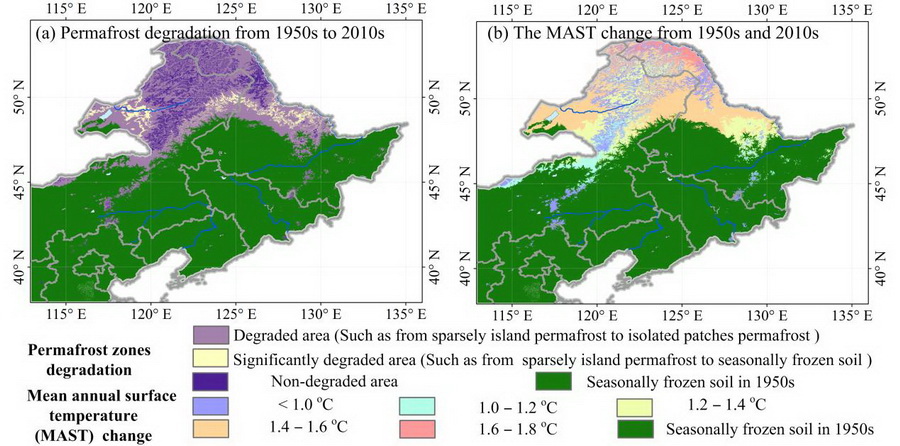Scientists Reveal Characteristics of Permafrost Degradation in Northeast China
Updatetime:2021-04-26From:
【Enlarge】【Reduce】
As a part of the “Xing’an-Baikal” permafrost, the permafrost in Northeast China is the transitional type between high latitude and high altitude permafrost, which is warmer and thinner than that in high-altitude and high-latitude areas, and is thus highly sensitive to climate warming.
The permafrost degradation in Northeast China was more significant than that in Western Siberia or the Arctic and Qinghai-Tibet Plateau areas, which has a significant and far-reaching impact on the regional ecological environment, hydrological processes, carbon cycle, and engineering design and maintenance in cold regions. However, the permafrost change in this region is still unclear.
Recently, a research team led by Prof. Wu Qingbai from the Northwest Institute of Eco-Environment and Resources (NIEER) of Chinese Academy of Sciences (CAS) elaborated the permafrost degradation characteristics in Northeast China over the past 70 years, and clarified the impact of environmental factors on the permafrost degradation.
Researchers used metrological data from 258 weather stations, alongside reanalysis data, and other environmental data to investigate permafrost degradation and its related environmental impacts in Northeast China from the 1950s to 2010s.
Results showed that the permafrost degradation exhibits certain latitude and high zonality. The total permafrost area decreased from 4.8 ×105 to 3.1 ×105 km2 from the 1950s to the 2010s (Fig 1a). The southern limit of the permafrost moved 0.1-1.1o northward, and its average elevation rose 160.5 m.
Research results indicated that the permafrost degradation was the result of the combined effect of surface temperature rise and environmental factors. The snowfall warming the ground surface temperature of 1.1-10.2 oC in cold seasons and rainfall cooling on surface conditions in warm seasons. Besides, forest fires, vegetation, urbanization and other human activities have promoted the permafrost degradation.
These results can provide important basic data for regional frozen soil research, engineering design and maintenance in Northeast China under conditions of the warming climate.
The research results have been published in Advances in Climate Change Research entitled Permafrost change in Northeast China in the 1950s-2010s. The research was funded by National Natural Science Foundation of China (41690144, 41771074).

Figure 1 Permafrost degradation (a) and mean annual surface temperature rise (b) in Northeast China during the 1950s-2010s (Image by ZHANG Zhongqiong)
Contact:
ZHANG Zhongqiong
E-mail: zhangzhongqiong@nieer.ac.cn
State Key Laboratory of Frozen Soils Engineering, Northwest Institute of Eco-Environment and Resources, Chinese Academy of Science, Lanzhou, China.
Appendix




